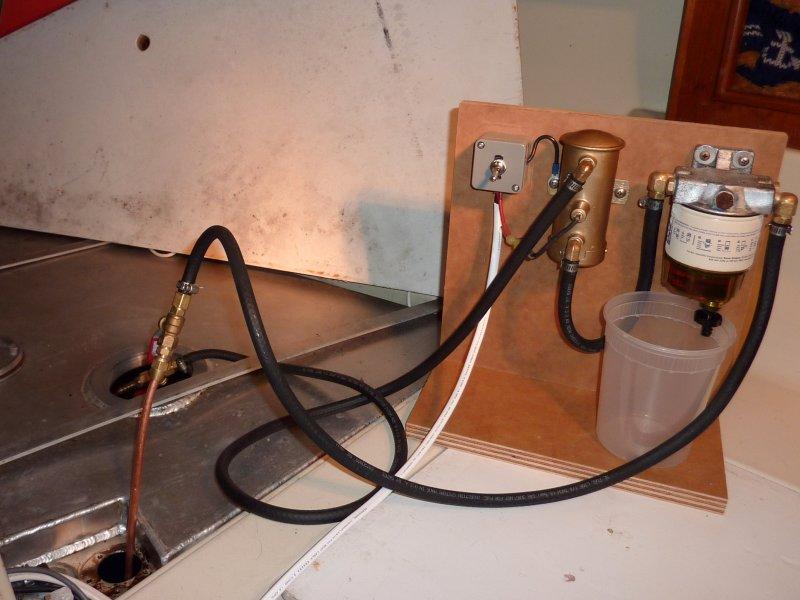I have about 3/4 tank of diesel fuel. It’s all of five years old. Only been day-sailing so very little fuel has been used.
I've been thinking of draining it. I hear horror stories of algae growing in the tank and getting into the injector system. I put Sta-bil in it every fall so I wonder, do I drain or not? Any suggestions??
The way I see it, it'll have to be taken out in gallon jugs. Even if I do drain it, how and with what do I clean the tank?
Thx, Pelican
Here's a definitive test to assay if your fuel is still usable:
1. remove some fuel from your tank and place into a clear glass container - old water glass.
2. hold the container between your eyeball and STRONG white light.
3. If you denote any 'haze' in the fuel, its
bad (loaded with a large amount of bioburden such as fungus such as cladosporium resinae or a bacteria such as brevundimonas aeruginosa - both common bio-species that use fuel oil as their nutrient source) and should either be recirculation polished or simply taken home and used in your house oil burner.
4. if the oil is CRYSTAL CLEAR, the probability is that the oil is still particle free (less than ~1-5µM and thus suitable for usage in a diesel engine.
Note if the Racor filters you use are 2µM --- change them immediately and replace with 10µM. The exception will be with 'some' Volvo engines that require 2µM; check your engine filter specs. if its a Volvo.
Notes on recirculation polishing:
• Recirculation polishing is only valid to KEEP a tank clean.
• Recirculation polishing is primarily used to constantly remove the small 'seed' particles upon which other particles agglomerate and 'grow' into larger and larger particles.
• Is valid for cleaning fouled fuel if and only if the cost of filters is LESS THAN the cost of simply draining and discarding the fouled oil
• Recirculation polishing WILL NOT 'clean' a tank. Mechanical scrubbing or 'steam cleaning' etc inside the tank are the only 'proven' ways to restore a tank to 'clean'. There are some chemical tank cleaners that use enzymes to break up and dissolve the thick colonies of bacteria and funguses ... but you will probably use a lot of expensive filters to remove what then breaks loose and is not 'dissolved'.
Use chemical tank cleaners for 'low levels' of tank fouling or to accomplish 'routine/seasonal maintenance' of an already CLEAN tank.
• Recirculation polishing is typically done with large surface area or 'depth-type' filters that have large 'dirt capacity' and is usually done with filter retention at 3 to 5X the desired µM rating of the typical 10µM 'workhorse' filter in the system. Recirculation filtration is done by a 'high turnover' pump system which depends on MANY 'tank turnovers' to obtain the
dilution of particles in the tank by a statistical reduction process. Typical recirculation polishing flow rate of such a pump system for onboard a typical diesel engine/tank on a recreational boat is typically
3 gallons per MINUTE per 100 gallons of tank capacity. That recirculation filtering at 15-30µM is left to 'run' continuously until the fuel becomes 'crystal clear' - usually happens when the majority of particles left in the tank are at 1-3µM (oil has
no haze and is crystal clear when viewed with STRONG white light, as above).
Oil that has become 'black' or 'dark' usually denotes
massive amounts of 'soft and deformable' particulates at LESS THAN 1µM; 'dump it' into your home oil burner system, dont waste time and money trying to 'polish' it as these 'submicronic' particles will constantly 'agglomerate' into larger and larger and larger particles over time. "Good oil" is crystal clear.
Rx:
1. if fuel is crystal clear (via 'haze test') keep it and use it.
2. If fuel is 'dark' or cannot pass the 'haze test', remove it and burn it in a home oil burner -
then, get inside the tank and CLEAN IT OUT by hand scrubbing, etc. the tank walls.
2a. Recirculation polishing a fouled tank will be of absolutely NO benefit.
3. Fuel 'stabilizers' and performance enhancing additives will not prevent FUNGUS or bacteria infections -
the CHIEF CAUSE of fouled fuel. You need a 'bacteriostat' such a BIOBOR to keep the tank fungus or bacteria under control.
4. Buy your fuel only from a 'high turnover' fuel source such as a depot that caters to 'watermen' or jug it to your boat from a 'truck stop'.
5. Drain/Empty the tank for long term haul outs or lay-ups.
6. Typical diesel fuel filtration is: 30µM if tank often becomes fouled --->10µM (Racor) ---> 15-17µM (small engine mounted 'guard' filter). The 'guard' filter is ONLY there to act as a 'fuse' if the preceding filters fail or begin to extrude soft and deformable particles. Some specific Volvos specify the use 2µM filters (crazy!!!).
Typical engine filter system: 30µM (optional)--->
10µM --->15-17µM (guard filter).


